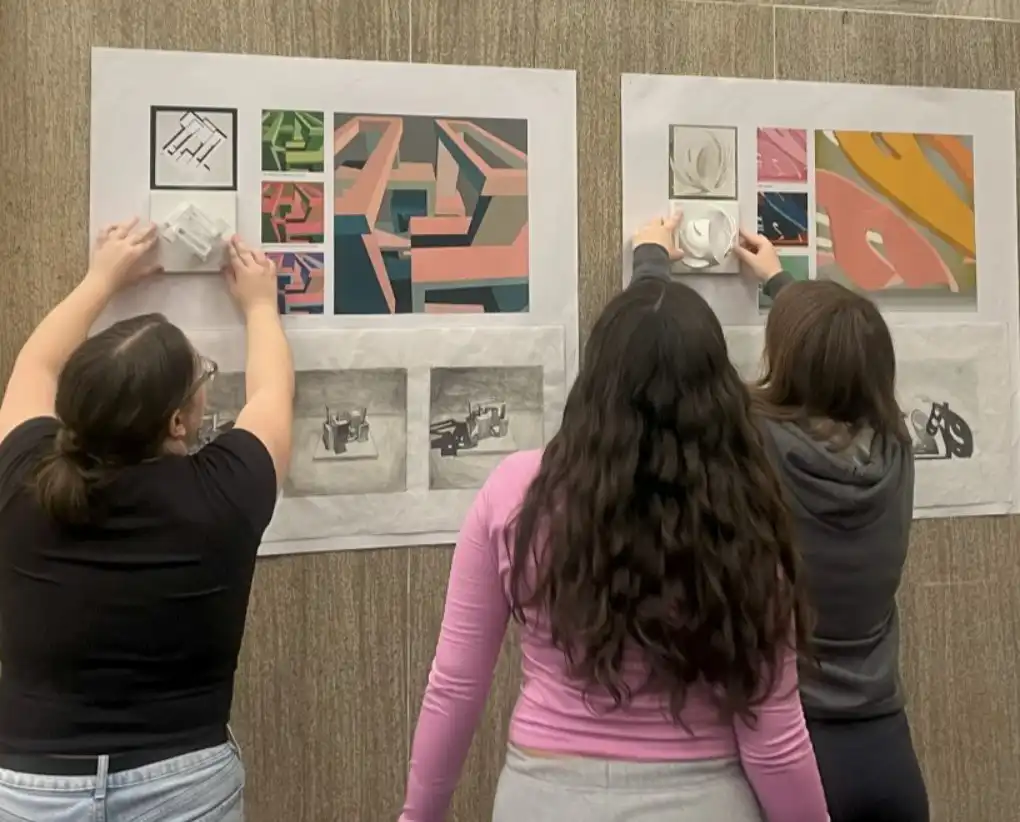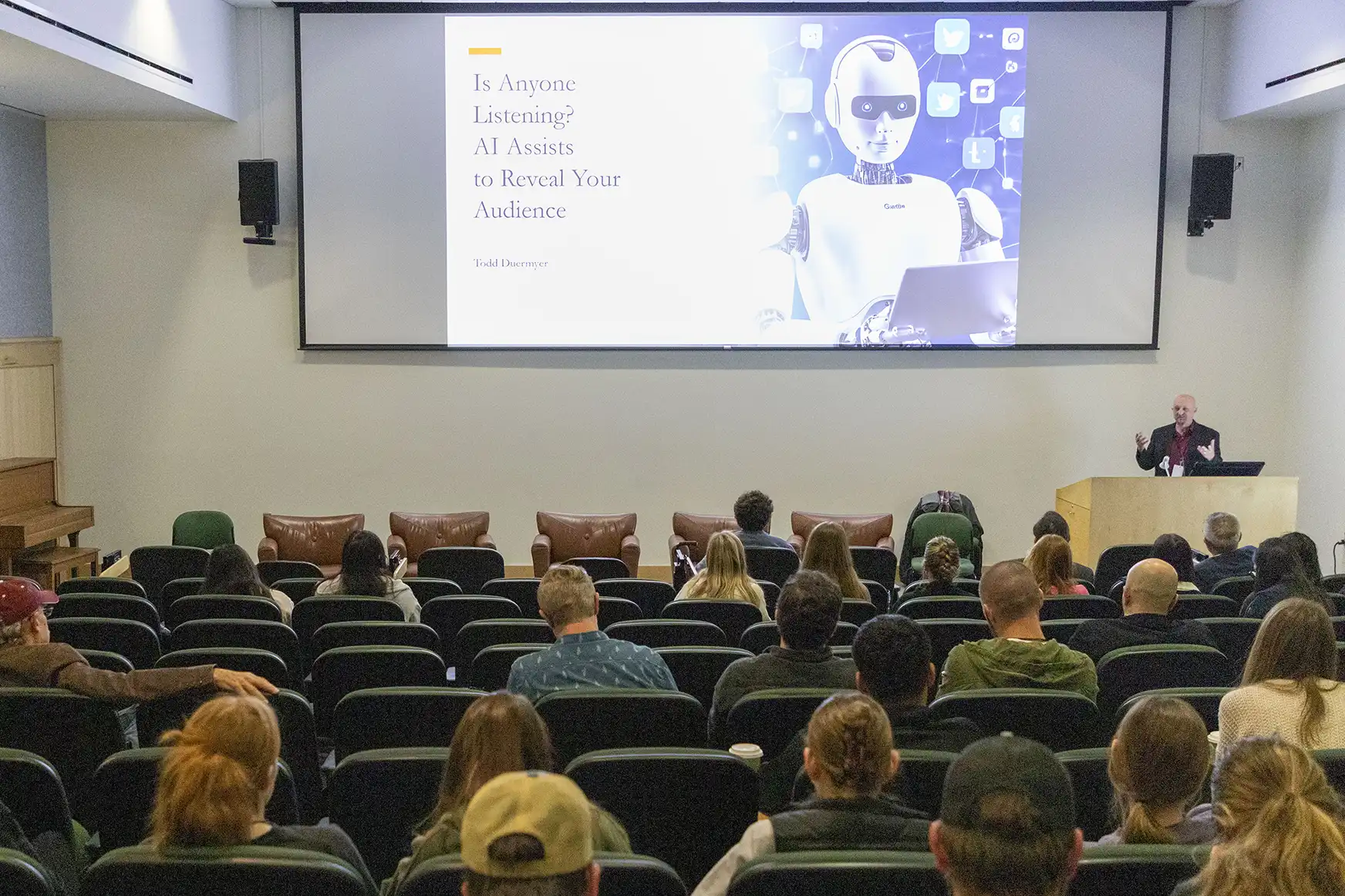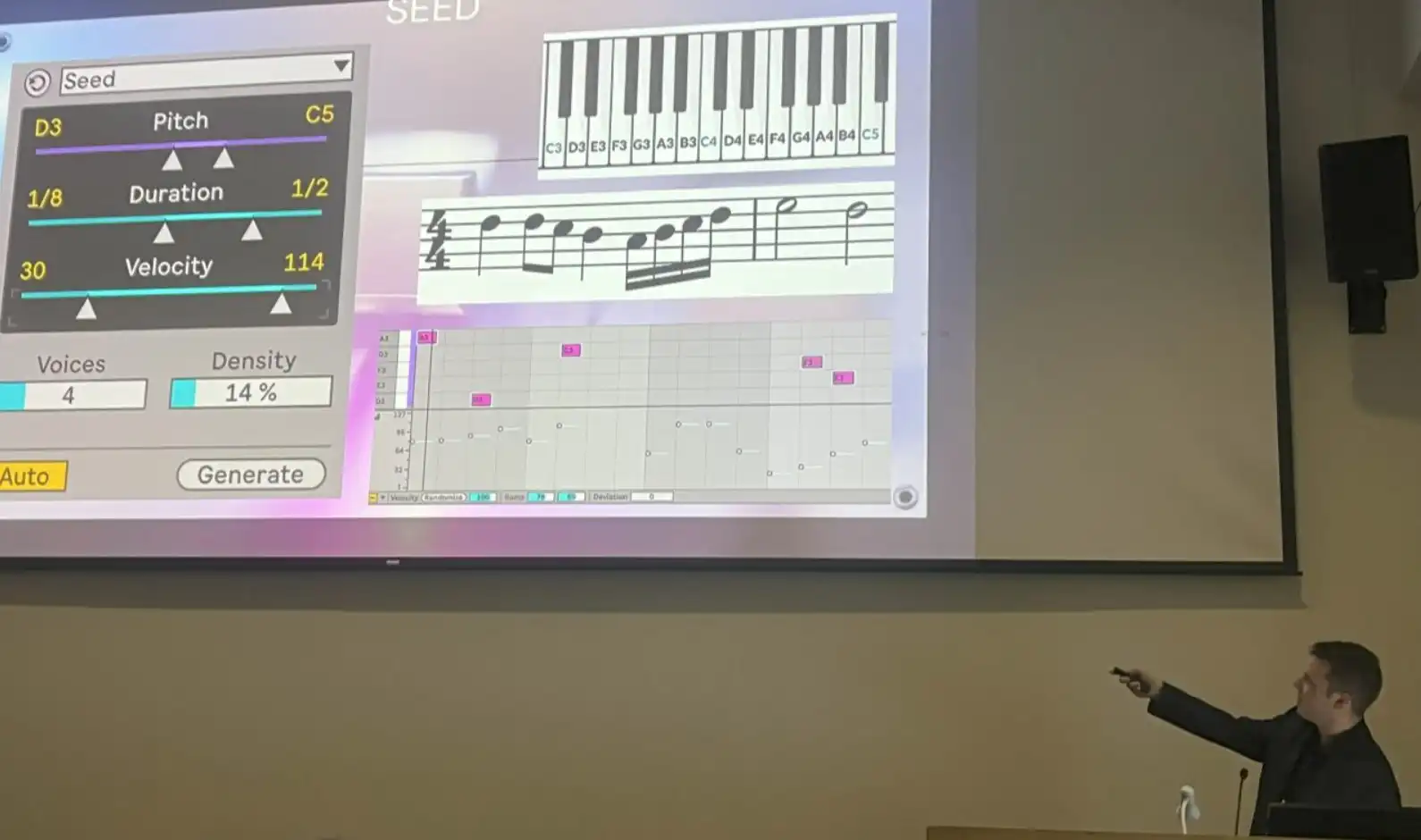
Students at Southern Illinois University, Carbondale, make final touches to showcase pieces for AI symposium.
While the roots of Artificial Intelligence (AI) are deeply embedded in fields like computer science and engineering, its applications have significantly expanded over the years to now offer innovative opportunities for creative fields such as art, design and media.
Rather than watching advances in technology pass them by, the College of Arts and Media (CAM) at Southern Illinois University, Carbondale, (SIUC) is leading a charge in pursuit of integrating AI into its programs. SIUC is one of ORAU’s university consortium members, and its CAM applied for ORAU’s Innovation Partnership Program with an idea to create a symposium to dive into the world of AI. SIUC was one of 15 consortium members to be awarded a grant for a project in 2025, and they swiftly embarked on an ambitious journey to showcase AI integration within their curriculum and beyond. I was fortunate to be able to participate virtually in the symposium.
Innovation Partnerships Program
To tell you about what all the symposium explored, let me first tell you about ORAU’s Innovation Partnership Program. It’s an opportunity we offer our university consortium members to apply for grants that are structured to build strong relationships between those members and ORAU collaborators by focusing on research and education topics that align with ORAU’s expertise and current priorities. Learn more about ORAU’s Innovation Partnerships Grant Program.
SIUC’s idea to delve into AI is timely because in the first week of President Donald Trump’s second term, he issued an executive order called “Removing Barriers to American Leadership in Artificial Intelligence.” The order states, “It is the policy of the United States to act decisively to retain global leadership in artificial intelligence.” Because SIUC (and specifically CAM) was already integrating AI into curriculum and daily practice, the symposium was a passion project that came together quickly. The submitted proposal indicated the event would “explore the transformative potential of AI in arts, design, and media, focusing on the technological, social, and ethical dimensions of these advancements.”
AI and innovative technology in art, design and media
SIUC’s CAM was awarded a grant to create the first conference of its kind on their campus, focused on artificial intelligence. They titled it CAM x AI: Innovating Creativity Symposium. Conversations throughout the event did not seek to answer whether AI belongs in the creative space. That was a foregone conclusion: AI is already there. So, rather, speakers and facilitators asked how creators shape the relationship with AI in their disciplines. It was fascinating to hear from several SIUC faculty—early adopters of AI—about how they use innovative technology in their classrooms every day.

Through ORAU’s Innovation Partnerships Grant Program, SIUC hosted CAM x AI: Innovating Creativity Symposium.
Integrating AI into art, design and media is not only a tool for efficiency (such as generative art and content curation applications) but also a collaborator in the creative process (such as fashion trend forecasting and virtual staging). Can humans truly collaborate with machines without working themselves out of a job? Stay tuned for my thoughts after learning from all the symposium presentations.
About the symposium
To prime the day’s presentations, the morning keynote speaker was introduced as a writer who is employed to build AI simulations for med students to practice end-of-life conversations. Say what? Yes, Pinckney Benedict is a former faculty member of SIUC’s Creative Writing program and is now working at the Southern Illinois University School of Medicine as the school’s chief architect of the AI/AR (augmented reality) simulation lab. He integrates generative AI into both his creative work and medical education initiatives. That is, Benedict says he writes “plays” for med students to train for some of the hardest interpersonal scenarios they face. He explained that reading “stage directions” in a simulation can help prepare medical staff for real-life experiences. He challenged the symposium participants to suspend judgement about a subject to learn more about it.
From there, a series of SIUC faculty members gave flash talks. In three minutes, they shared how they are using AI. The quick presentations covered topics from game design to the move from rule-based AI to generative AI, and from detecting deep fakes to using AI to help students practice public speaking. The symposium crowd also learned about audience listening tools and how AI can help compose music by giving inputs such as scale, pitch range and rhythmic duration.

AI can be used to help compose music.
Then, it was the students’ turn. Students had the opportunity to present some of their recent work with AI including interior design, virtual walkthroughs and art. After the digital demonstrations, the work was also showcased for people to peruse during the lunch hour.
The afternoon keynote address had a provocative title: The Last Job for You and Me. Tao Huang, Ph.D., is the chair of East Tennessee State University’s Department of Art and Design. With 25 years in design research, user experience design, product design, and more, Dr. Huang posed questions to consider when utilizing AI. Among the queries she offered, Dr. Huang instructed the audience to be thoughtful in contemplating critical thinking vs. efficiency (speed over nuanced work) and purpose vs. boundary (achieving a goal while ignoring unwritten rules of a social contract). She submitted that using artificial intelligence is a practical option but that users must employ responsibility when doing so.
The symposium ended with a virtual workshop hosted by the AIxCreative team, which bills itself as the leading source for AI design content and education. The company’s founder, Hector Rodriguez, told the symposium audience that in the design world, sometimes we slip into thinking that we operate tools, but we actually tell stories. Rodriquez called design a game of clues where the creator can take text or a flat picture and craft a 3D image. As the audience watched, he pulled up a few platforms where he went through the motions of giving the platform inputs (or “levers”) and editing that information until he got exactly what he wanted the design to be. Throughout the demo, he explained that the most important skill is to understand the language of the tool you’re using.

SIUC’s AI symposium ended with a virtual workshop.
Ethics
Of course, when it comes to AI, the elephant in the room is ethics. Just because you can, should you? Though machine learning has been around for decades, the next generation of artificial intelligence is still a wild frontier. Many AI engineers agree that boundaries and rules are needed because we’re building the plane as it’s flying, so to speak. The CAM x AI: Innovating Creativity Symposium was a great vehicle to host these kinds of conversations, which accomplished one of its stated goals. Organizers intended to foster meaningful discussions among students, faculty, industry/community professionals to inspire collaboration and promote innovation in the convergence of AI and arts, design and media (all while considering the ethical ramifications of such technology). From sharing applications already in practice to future possibilities, participants were given the opportunity to develop their understanding and appreciation for AI.
My AI-generated ending to this article
After having the chance to be a fly on the wall throughout the event, my take is that even with the integration and widespread adoption of AI into all areas of life, there will always be a need for thoughtful prompts (hence, thoughtful prompters!). Will computers replace human jobs? Some will, but not completely. Human sentience cannot be fully replaced. Still, it’s wise that we learn how to use the tools effectively so there’s always a need for someone to feed the machine.
To test this, I thought I’d close with a little AI in action. I decided the best way to wrap up would be to ask AI do it for me. You saw this coming, right?
Here’s my AI generated closing. For the prompt, I plugged in what I’ve already written and asked it to give me a 250-word ending. It took about eight seconds to populate, and I spent just a minute or so formatting. How do you think it did?

Screenshot of my prompt in my company’s AI sandbox we use for work.
The CAM x AI: Innovating Creativity Symposium at SIUC showcased not only the transformative potential of artificial intelligence but also the importance of thoughtful integration into creative fields. The event underscored that AI is not merely a tool—it’s a collaborator, a provocateur, and a catalyst for innovation. From faculty flash talks to student showcases, the symposium revealed how AI is already reshaping the creative process, enabling new possibilities in art, design, and media.
Yet, as the symposium highlighted, the adoption of AI comes with significant ethical considerations. Questions about purpose, responsibility, and boundaries remain paramount as we navigate this technological frontier. The discussions at the event emphasized the need for intentionality, critical thinking, and collaboration to ensure that AI serves as an enabler of creativity rather than a substitute for human ingenuity.
Ultimately, the symposium succeeded in fostering meaningful dialogue and inspiring participants to explore AI’s role in the creative space. It demonstrated that while AI can enhance efficiency and expand creative horizons, human input—our ideas, values, and stories—remains irreplaceable. As we move forward, events like CAM x AI remind us that the convergence of technology and creativity is not about choosing between humans and machines; it’s about finding ways for them to work together harmoniously.
In the ever-evolving landscape of AI, one thing is clear: the future of creativity will be shaped not just by the tools we use, but by the thoughtful and ethical ways we choose to wield them.